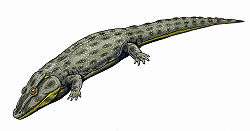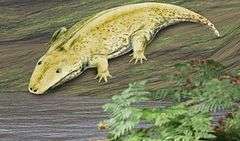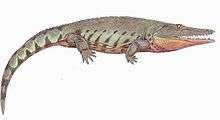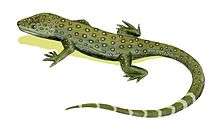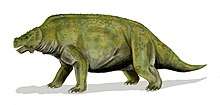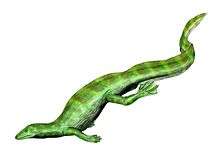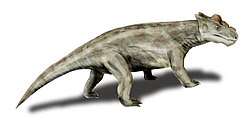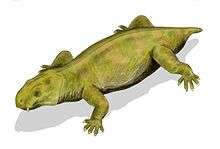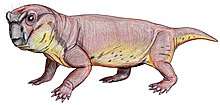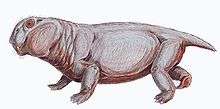Changhsingian
In the geologic time scale, the Changhsingian or Changxingian is the latest age or uppermost stage of the Permian. It is also the upper or latest of two subdivisions of the Lopingian epoch or series. The Changhsingian lasted from 254.14 to 251.902 million years ago (Ma). It was preceded by the Wuchiapingian and followed by the Induan.[2]
| System/ Period |
Series/ Epoch |
Stage/ Age |
Age (Ma) | |
|---|---|---|---|---|
| Triassic | Lower/ Early |
Induan | younger | |
| Permian | Lopingian | Changhsingian | 251.902 | 254.14 |
| Wuchiapingian | 254.14 | 259.1 | ||
| Guadalupian | Capitanian | 259.1 | 265.1 | |
| Wordian | 265.1 | 268.8 | ||
| Roadian | 268.8 | 272.95 | ||
| Cisuralian | Kungurian | 272.95 | 283.5 | |
| Artinskian | 283.5 | 290.1 | ||
| Sakmarian | 290.1 | 295.0 | ||
| Asselian | 295.0 | 298.9 | ||
| Carboniferous | Pennsylvanian | Gzhelian | older | |
| Subdivision of the Permian system according to the ICS, as of 2017.[1] | ||||
The greatest mass extinction in the Phanerozoic eon, the Permian–Triassic extinction event, occurred during this age. The extinction rate peaked about a million years before the end of this stage.
Stratigraphic definitions
The Changhsingian is named after Changxing (Chinese: 长兴; pinyin: Chángxìng; Wade–Giles: Ch’ang-hsing) in northern Zhejiang, China. The stage was named for the Changhsing Limestone.[3] The name was first used for a stage in 1970[4][5] and was anchored in the international timescale in 1981.[6]
The base of the Changhsingian stage is at the first appearance of the conodont species Clarkina wangi. The global reference profile is profile D at Meishan, in the type area in Changxing.[6] The top of the Changhsingian (the base of the Induan stage and the Triassic system is at the first appearance of the conodont species Hindeodus parvus.
The Changhsingian stage contains only one ammonite biozone: that of the genus Iranites.
Palaeontology
The Changhsingian ended with the Permian–Triassic extinction event when both global biodiversity and alpha diversity (community-level diversity) were devastated.[7] The world after the extinction was almost lifeless, deserted, hot, and dry. Ammonites, fishes, insects, and the tetrapods (cynodonts, amphibians, reptiles, etc.) remained rare and terrestrial ecosystems did not recover for 30 million years.[7]
Changhsingian Life
Actinopterygians
| Actinopterygii of the Changhsingian | ||||
|---|---|---|---|---|
| Taxa | Presence | Location | Description | Images |
| Lopingian | Italy | A neopterygian |
| |
| Lopingian to Middle Triassic | Italy | A bobasatraniid non-neopterygian | ||
| Lopingian | Australia | A bobasatraniid non-neopterygian | ||
| Lopingian | China | A saurichthyid non-neopterygian | ||
|
Permian | Russia | A palaeonisciform non-neopterygian with long pelvic fins | |
Coelacanths
| Actinistia of the Changhsingian | ||||
|---|---|---|---|---|
| Taxa | Presence | Location | Description | Images |
| Lopingian | China | |||
| Lopingian | China | |||
Lungfishes
| Dipnoi of the Changhsingian | ||||
|---|---|---|---|---|
| Taxa | Presence | Location | Description | Images |
| Permian to Early Triassic | Russia | A gnathorhizid dipnoan |
| |
†Temnospondyls
| Temnospondyli of the Changhsingian | ||||
|---|---|---|---|---|
| Taxa | Presence | Location | Description | Images |
| Buena Vista Formation, Norte Basin, Uruguay | A genus of temnospondyl amphibian. Arachana was a basal member of Stereospondyli that shared traits with more derived stereospondyl taxa like Lydekkerinidae and especially Rhinesuchidae. Its transitional features place it as part of an entire transitional fauna that existed around the Permo-Triassic boundary. |
| ||
| Inta Formation, Russia | Intasuchus was a genus of temnospondyl amphibian, possibly an archegosauroid. | |||
| Moradi Formation, Niger | A genus of edopoid temnospondyl within the family Cochleosauridae. | |||
| Moradi Formation, Niger | A genus of basal temnospondyl. | |||
| Lopingian | Normandien Formation, South Africa | A rhinesuchid temnospondyl. | ||
†Chroniosuchians
| Chroniosuchia of the Changhsingian | ||||
|---|---|---|---|---|
| Taxa | Presence | Location | Description | Images |
| Lopingian to Early Triassic | Russia, China | A reptiliomorph |
| |
| Lopingian | Russia | A reptiliomorph | ||
| Lopingian | Russia | A reptiliomorph | ||
†Seymouriamorphs
| Seymouriamorpha of the Changhsingian | ||||
|---|---|---|---|---|
| Taxa | Presence | Location | Description | Images |
| Lopingian | Russia | A seymouriamorph reptiliomorph |
| |
†Millerosaurs
| Millerosauria of the Changhsingian | ||||
|---|---|---|---|---|
| Taxa | Presence | Location | Description | Images |
| Lopingian | South Africa | A parareptile |
| |
| Lopingian | South Africa | A parareptile | ||
| Lopingian | South Africa | A parareptile | ||
†Procolophonomorphs
| Procolophonomorpha of the Changhsingian | ||||
|---|---|---|---|---|
| Taxa | Presence | Location | Description | Images |
| Lopingian | Niger | A pareiasaurid parareptile |
| |
| Lopingian | Scotland | A pareiasaurid parareptile | ||
| Lopingian to Early Triassic | South Africa | An owenettid parareptile | ||
| Lopingian to Early Triassic | South Africa, Brazil, Antarctica | A procolophonid parareptile | ||
| Lopingian | Russia | A pareiasaurid parareptile | ||
Diapsids
| Diapsida of the Changhsingian | ||||
|---|---|---|---|---|
| Taxa | Presence | Location | Description | Images |
| Lopingian to Early Triassic | Madagascar | An aquatic claudiosaurid reptile |
| |
| Lopingian to Early Triassic | Madagascar | An aquatic tangasaurid younginiform reptile | ||
| Lopingian to Early Triassic | Madagascar | An aquatic younginid younginiform reptile | ||
| Lopingian | Madagascar | An aquatic tangasaurid younginiform reptile | ||
| Lopingian | Madagascar | An aquatic younginid younginiform reptile | ||
Therapsids
| Therapsida of the Changhsingian | ||||
|---|---|---|---|---|
| Taxa | Presence | Location | Description | Images |
| Lopingian | South Africa | A biarmosuchian therapsid |
| |
| Lopingian | South Africa | A basal dicynodont therapsid | ||
| Lopingian | South Africa | A dicynodontid therapsid | ||
| Lopingian | South Africa | A dicynodontid therapsid | ||
| Lopingian | South Africa | A dicynodontid therapsid | ||
| Lopingian | Scotland | A dicynodontid therapsid | ||
| Lopingian | Scotland | A dicynodontid therapsid | ||
| Lopingian | Russia | A gorgonopsian therapsid | ||
| Lopingian to Early Triassic | South Africa | A dicynodontid therapsid | ||
| Lopingian | Russia | A dicynodontid therapsid | ||
References
- "Chart/Time Scale". www.stratigraphy.org. International Commission on Stratigraphy.
- Gradstein, F.M.; Ogg, J.G. & Smith, A.G.; 2004: A Geologic Time Scale 2004, Cambridge University Press
- Grabau, A.W.; 1923: Stratigraphy of China, Part 1: Palaeozoic and lower, Geological Survey of China, 529 pp.
- Furnish, W.M. & Glenister, B.F.; 1970: Permian ammonite Cyclolobus from the Salt Range, West Pakistan, in: Kummel, B. & Teichert, G. (eds.): Stratigraphic boundary problems, Permian and Triassic of west Pakistan, Geological Department of Kansas University, Special Publication 4, pp 158–176.
- Furnish, W.M. & Glenister, B.F.; 1973: Permian stages names, in: Logan, A. & Hills, L.V.: The Permian and Triassic systems and their mutual boundary, Canadian Society of Petroleum Geologists Memoir 2, pp 522–548.
- Jin, Y.; Wang, Y.; Henderson, C.; Wardlaw, B.R.; Shen, S. & Cao, C.; 2006: The Global Boundary Stratotype Section and Point (GSSP) for the base of Changhsingian Stage (Upper Permian) Episodes 29(3), p. 175-182, PDF.
- Sahney, S.; Benton, M.J. (2008). "Recovery from the most profound mass extinction of all time" (PDF). Proceedings of the Royal Society B: Biological Sciences. 275 (1636): 759–65. doi:10.1098/rspb.2007.1370. PMC 2596898. PMID 18198148.
External links
- GeoWhen Database - Changhsingian
- Upper Paleozoic stratigraphic chart at the website of the subcommission for stratigraphic information of the ICS



